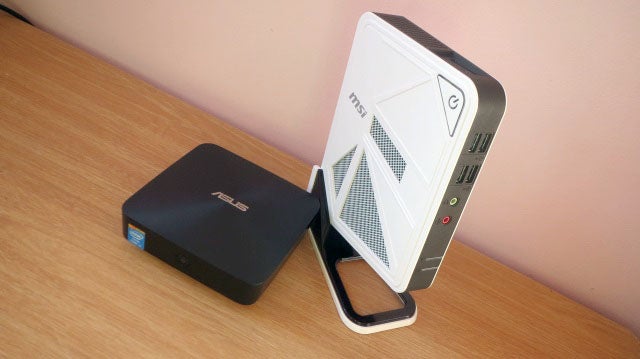Asus VivoMini UN62-M018M vs MSI Wind Box DC111-053EU

Other things to consider
Both firms sell alternative specifications. MSI’s system is available with a 120GB Kingston SSD that will cut down on storage space but improve responsiveness – and it’s no more expensive than the hard disk version.
Asus sells one other version of its VivoMini, with a Core i5-4210U processor and the same components elsewhere. Its 1.7GHz stock speed is bolstered by being able to Turbo boost up to 2.7GHz, and it’s got Hyper-Threading.
That’s a barebone unit too, and that’s the big thing you’ll have to bear in mind with the VivoMini – the mSATA connection and better processors mean this machine is faster than the MSI, but if you don’t have spare components then the price is going to add up.
Four gigabytes of dual-channel DDR3 laptop memory will cost at least £30, and you’ll need to pay £50 or more for an mSATA SSD. No operating system is installed, either, so that’s another potential £50+ unless you’re willing to use Linux.

Should I Buy the Asus VivoMini UN62-M018M or MSI Wind Box DC111-053EU?
These two machines are only £62 apart at the checkout, but they’re vastly different. MSI’s machine is a complete system, with Windows 8.1, for just £185. It’ll be tough to find such a good deal elsewhere, which makes it a good entry-level machine.
What the Wind Box wins in value, though, it loses in performance. Its Intel Celeron processor can’t compete with the VivoMini’s Core i3 in applications or games, and its hard disk further hampers responsiveness – getting the SSD version would be a better bet.
The VivoMini is quicker, better-looking and with superior connectivity, but it’s more expensive even before the cost of the memory, hard drive and operating system that you’ll need.
The MSI’s modest performance and low price mean it’s only suitable for basic computing. The Asus has the versatility to function as a home or office system with a broader remit, but you’ll pay more for the privilege.
SEE ALSO: More Desktop PC reviews
Verdict
These PCs are both tiny, low-power and easily customisable, but that’s’ where the similarities end. MSI’s machine is a cheaper full system with Windows 8.1, but its lesser components mean it’s only suitable for low-end tasks – and the Asus is a barebone machine with the added cost of components and software, but it’s a more capable system for the house and the office.


